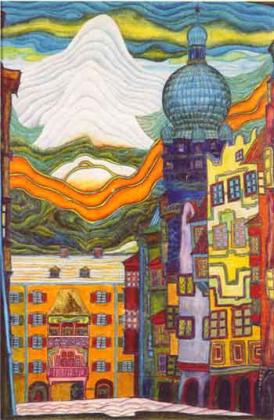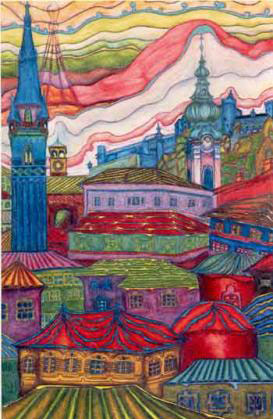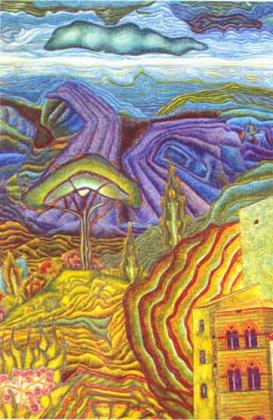
Press



The fantastic architecture of Werner Schulz-Mönkeberg
Painting like an internal diary, pouring his heart out in vivid pictures: Frankfurt-born, Vienna-based artist Werner Schulz Mönkeberg has made animating the inanimate his primary artistic activity. In his pictorial meditations a simplified representation prevails over the abstract ornamental emblematics. A varied rhythm between lines and surfaces is his favourite compositional principle, a denatured and emotionally induced colouration is his typical design.
The topics of his paintings reveal the gentle rebellion of the creative forces in the individual against the confining diseases of civilization and constraints which we have to face on a daily basis. In times in which processes of life are ruled by machines, Werner Schulz-Mönkeberg's pictures offer possibilites that lie beyond the range of practical usefulness. Werner Schulz-Mönkeberg paints pleadings: He advocates the imagination of the individual and opposes the depersonalized, dehumanized society routine.
His motifs are to be found, according to this basic instinctive attitude, especially in the field of the environment: Environment, understood as an (urban) landscape, as architecture. His paraphrases of architecture are part of his scope of imagination. What he demonstrates is, above all, this: a reasonably made and also artistically relevant fantasy architecture. Houses, individual buildings, and entire city views - like the "Viennese Impressions" - are prototypes of his imagination. Creative architecture as wishful thinking that takes into account individuals. Full of colourful oddities, the motifs lose their literality, and leaving behind their conventional meanings, they move into another dimension - the dimension of poetics.
It doesn't seem to be a particularly important feature that in the creation of his artistic concerns, he has opted for a specific tool, the simple coloured pencil, which Werner Schulz-Mönkeberg has more and more focused on during his artistic work. Working with a coloured pencil goes hand in hand with his penchant for the meticulous, his almost pedantic passion for detail, and his perfidious workaholism, often over long periods of time.
Formally, the "Viennese Impressions" appear as a good example of his specific type of realization. The combinatorics of the steep top view and the horizontal sequence and structure in this picture convey the delightful and subtle impression of the naturally created atmosphere that is oriented towards the real world of desires. Reality is understood as nothing more but a stimulus. The differentiated fantastic colouring of this view of the city underlines this impression.
Of importance is a phenomenon in the picture that can be found again and again in many others of his works: The cell-like composition process. By carefully parcelling and looking over the illustrated parts of fantastic zones, he achieves an effect that can be summed up best by the term "kaleidoscope landscape". Because the world portrays itself here like seen through a kaleidoscope: The relationship of the different colour sections, the colour relations chosen by Schulz-Mönkeberg, which vary between tone-on-tone-painting and striking immediacy, and a directness brought about by a contrastive colour surface effect, are fascinating.
In his choice of subjects, Werner Schulz-Mönkeberg is not limited exclusively to architecture prototypes. Landscape and nature are equally among his favourite motifs. But they are always found in the same context which becomes obvious in the city pictures: Even if it's a flower or a tree that is at the center of the dream world of this artist, they always become an environmentally formative factor: a factor that has the function of modifying the human habitat - meticulously formed at the level of simple poetry.
Liesbeth Böhm, Wien
Poetic world view
Lovely exhibition of the Viennese artist Schulz-Mönkeberg at Alfermann's
The exhibition of the 38-year-old Vienna-based Werner Schulz-Mönkeberg in Ohligser Gallery Alfermann fascinates art lovers especially, because a really simple artistic material, namely common coloured pencils, produces a magical effect.
The coloured pencils create a transparent structure that does not even get lost if - that's know-how - up to a dozen applications are laid on top of each other, which produces impressive effects. In addition, the pictures carry a thumbprint that covers heavy pressure or just slight blurring. Thus, without any technical mumbo jumbo, an honest art is created that makes use of narrative moods, amiable irony, philosophical approaches, and above all musicality to narrate about our environment.
Cities, landscapes, people, animals, reflections and still life are drawn. Everything stays almost realistic, but is arranged in distinctive and unconventional relationships, so that a downright small and highly personal world view is formed.
It tells us about a man, who as a choirboy in the Laubacher church choir first came into contact with art, and after some office jobs delved into the pictorial storytelling and meditation, eventually building his life on it. Exhibitions in Austria and Southern Germany brought the Frankfurt-born considerable success, the art critics praised him for instance in a large report in an important art journal; and his first presentation in an Alfermann's collective exhibition aroused unprecedented response.
All this is justified by an art that combines cheerful and serious aspects, effortlessly transcends the mere craftsmanship, and spreads new images from mental strength.
A truly sensational exhibition.
Hans Karl Pesch
Rheinische Post, 1.2.1975
All that glitters is not oil
Werner Schulz-Mönkeberg was born in Frankfurt - "then it's easier to prefer Vienna" - and makes a living from his painting.
His idiosyncratic technique reveals a lot of his idiosyncratic character: He paints with coloured pencils. The colors of the pencils are ground on the smooth cardboard - either in dry condition or with turpentine. The effect is astonishing: Exact working through the details in a stressed mood fairyland. The details appear like in an atmospheric fairyland.
On one the hand there's fantasy, a tendency towards naive fairy tales; on the other hand, there's criticism, mockery and the fear of an unambiguous declaration.
This discrepancy in the topics of his pictures easily irritates the viewer. "One day Vienna will not survive - only its cultural monuments," says the painter and leaves it open whether this is good or bad. Schönbrunn, the Ferris Wheel, St. Stephen's Cathedral, St. Charles' Church - will this all have been part of an unnecessary past?
The painter prefers livelier architecture.
Like so many artists nowadays, Werner Schulz-Mönkeberg is concerned about the formation of the environment. He isn't against standardized buildings, but if enough money is available, one might come up with something special. Flowers are the simplest and most decorative means of making life more bearable. As an example, he displays "Beethoven's house in flowers".
Residential towers with butterfly roofs or panoramic houses bring the landscape into the house. For adventurous travellers he proposes a "house for flying".
Mobile line - mobile life
Werner Schulz-Mönkeberg loves the 'flowing' line in his pictures; rigid contours are dead. A moderate Hundertwasser? Dressed in Hutter's colours? Fantastically realistic in any case.
Baden's Newspaper
A Paradise for the Eyes
A paradise for the eyes are the pictures of Werner Schulz-Mönkeberg, painted mostly with coloured pencils in the style of fantastic realism. Werner Schulz- Mönkeberg, an amateur cook and grower of bonsais, was born in 1938 in Frankfurt / Main, was a choirboy in his youth, became an industrial merchant and studied further to become an advertising expert.
In 1965 he was brought to Vienna by his advertising agency; since 1966 he worked exclusively as a freelance artist, and in 1972 he became an Austrian citizen. His first exhibition dates back to 1971 in Baden at Beethoven's House, where he exhibited his pictures - imaginative landscapes, architecture and animals; mainly fish in bizarre variations and almost without people. His technique, which allows a very precise work, is drawing with coloured and normal pencils on a special board.
Mixed technique and oil paintings are not often used by Werner Schulz Mönkeberg.
Baden's Newspaper
Copyright © 2012 Werner Schulz-Mönkeberg.
Letzte Aktualisierung: 26.05.2014